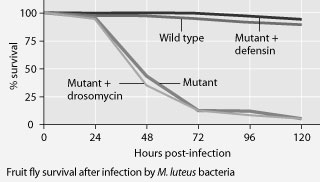Instructions for Side by Side Printing
- Print the notecards
- Fold each page in half along the solid vertical line
- Cut out the notecards by cutting along each horizontal dotted line
- Optional: Glue, tape or staple the ends of each notecard together
Biology 1 Chapter 43 Homework
front 1 Which secretion is not a barrier that prevents pathogens from entering the body? | back 1 Antigens. |
front 2 True or false? The leukocytes of the innate immune system are B cells, macrophages, and neutrophils. | back 2 False |
front 3 How do cells involved in the innate immune response detect the presence of pathogens? | back 3 Leukocytes recognize unique molecules on pathogens. |
front 4 Which of the following cells can engulf a pathogen? | back 4 Macrophages. |
front 5 Which of the following statements best describes the role of mast cells in the inflammatory response? | back 5 They release chemicals that dilate blood vessels near the wound site, allowing blood components to enter the region from the bloodstream. |
front 6 Which of the following events occurs first when a wound that breaks the skin has occurred? | back 6 Platelets release proteins that form clots and decrease bleeding. |
front 7 The site of inflammation may become swollen due to the increased numbers of cells and fluids at the site and painful due to signals from pain receptors. | back 7 True |
front 8 Innate immunity and acquired immunity are both _____. | back 8 characteristics of all vertebrate animals |
front 9 Macrophages are _____. | back 9 large, phagocytic cells that can leave the circulation and enter the tissues of the body |
front 10 The cells and signaling molecules involved in the initial stages of the inflammatory response are _____. | back 10 mast cells and histamines |
front 11 Inflammatory responses typically include _____. | back 11 increased activity of phagocytes in an inflamed area |
front 12  Mutant fruit flies that make only one antimicrobial peptide were tested for survival after infection with Neurospora crassa fungi or with Micrococcus luteus bacteria. | back 12  adding the drosomycin gene to such mutants protects them from death by fungal infection |
front 13 Acidity in human sweat is an example of _____. | back 13 innate immunity |
front 14 An antigen _____. | back 14 is a foreign molecule that evokes a specific response by a lymphocyte |
front 15 The fact that there are about a million different antigen receptors possible in human B cells is based on _____. | back 15 recombination of the segments of the receptor DNA that make up the functional receptor genes of differentiated B cells |
front 16 Clonal selection is an explanation for how _____. | back 16 an antigen can provoke production of high levels of specific antibodies |
front 17 Immunological memory accounts for _____. | back 17 the ancient observation that someone who had recovered from the plague could safely care for those newly diseased |
front 18 How does an antihistamine reduce allergy symptoms? | back 18 An antihistamine blocks receptors for inflammatory chemicals released from granules within mast cells. |
front 19 Lymphocytes mature in the _____. I) spleen II) thymus III) bone marrow | back 19 only II and III |
front 20 Vaccination increases the number of _____. | back 20 lymphocytes with receptors that can bind to the pathogen |
front 21 What major advantage is conveyed by having a system of adaptive immunity? | back 21 It enables a rapid defense against an antigen that has been previously encountered. |
front 22 Which of the following is a difference between B cells and T cells? | back 22 One has a major role in antibody production, while the other has a major role in cytotoxicity. |
front 23 Cell-mediated immunity differs from humoral immunity in that _____. | back 23 they respond differently to invaders |
front 24 Helper T cells are part of _____. | back 24 cell-mediated immune responses |
front 25 A primary reason for needing a new vaccine for influenza each year is that _____. | back 25 mutation in the influenza virus is frequent |